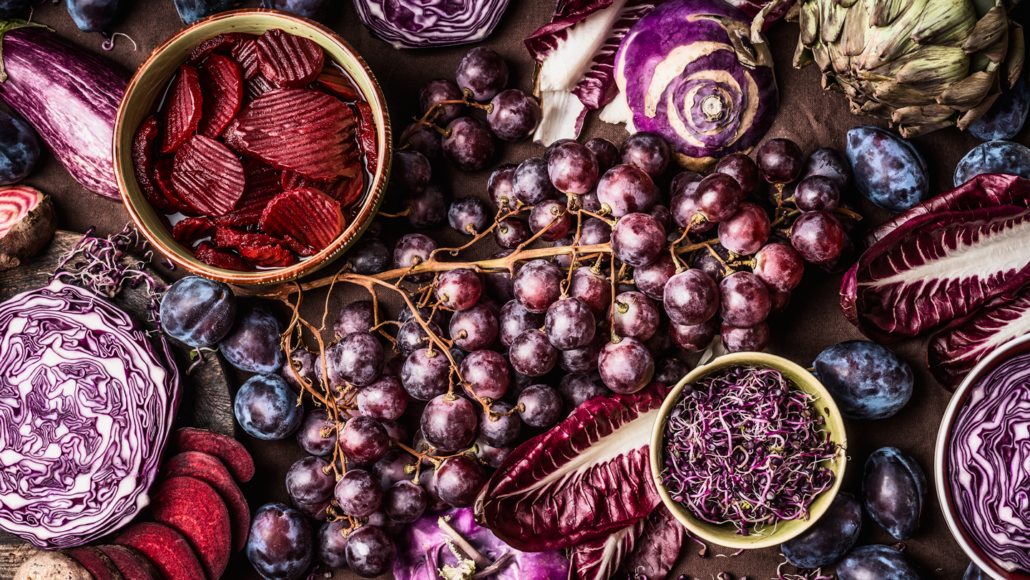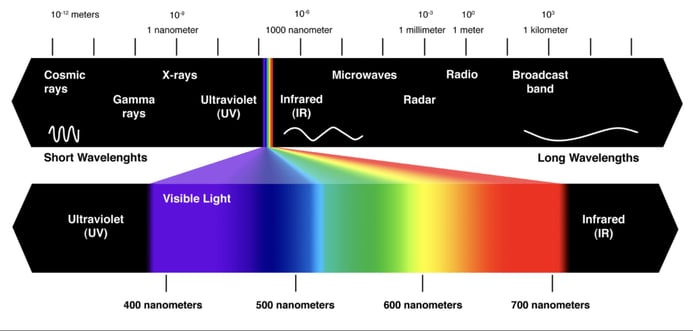
Posted on 02/03/2025 6:36:50 PM PST by Red Badger

There is something unique about the color purple: Our brain makes it up. So you might just call purple a pigment of our imagination.
It’s also a fascinating example of how the brain creates something beautiful when faced with a systems error.
To understand where purple comes from, we need to know how our eyes and brain work together to perceive color. And that all begins with light.
Light is another term for electromagnetic radiation. Most comes from the sun and travels to Earth in waves. There are many different types of light, which scientists group based on the lengths of those waves. (The wavelength is the distance between one wave peak and the next.) Together, all of those wavelengths make up the electromagnetic spectrum.
Our eyes can’t see most wavelengths, such as the microwaves used to cook food or the ultraviolet light that can burn our skin when we don’t wear sunscreen. We can directly see only a teeny, tiny sliver of the spectrum — just 0.0035 percent! This slice is known as the visible-light spectrum. It spans wavelengths between roughly 350 and 700 nanometers.
The acronym ROYGBIV (pronounced Roy-gee-biv) can be used to remember the order of colors in that visible spectrum: red, orange, yellow, green, blue, indigo and violet. You can see these colors in a rainbow stretching across the sky after a rainstorm or when light shines through a prism. In the visible spectrum, red light has the longest wavelength. Blue and violet are the shortest. Green and yellow sit toward the middle.
Although violet is in the visible spectrum, purple is not. Indeed, violet and purple are not the same color. They look similar, but the way our brain perceives them is very different.

How we see color
Color perception starts in our eyes. The backs of our eyes contain light-sensitive cells called cones. Most people have three types. They’re sometimes called red, green and blue cones because each is most sensitive to one of those colors.
But cones don’t “see” color, notes Zab Johnson. Instead, they detect certain wavelengths of light.
Johnson works at the University of Pennsylvania in Philadelphia. She and other scientists who study how we perceive color prefer to classify cones based on the range of wavelengths they detect: long, mid or short.
So-called red cones detect long wavelengths of light. Green cones respond most strongly to light in the middle of the visible spectrum. Blue cones best detect wavelengths toward the shorter end of the visible spectrum.
When light enters our eyes, the specific combination of cones it activates is like a code. Our brain deciphers that code and then translates it into a color.
Consider light that stimulates long- and mid-wavelength cones but few, if any, short-wavelength cones. Our brain interprets this as orange. When light triggers mostly short-wavelength cones, we see blue or violet. A combination of mid- and short-wavelength cones looks green. Any color within the visible rainbow can be created by a single wavelength of light stimulating a specific combination of cones.
:max_bytes(150000):strip_icc():format(webp)/the-visible-light-spectrum-2699036_FINAL2-c0b0ee6f82764efdb62a1af9b9525050.png)
Notice that the visible spectrum is a gradient. One color gradually shifts into the next. The activity of cones activated by the light also gradually shifts from one type to the next. At the red end of the spectrum, for instance, long-wavelength cones do most of the work. As you move from red to orange, the mid-wavelength cones help more and the long-wavelength cones do less.
In the middle of the rainbow — colors like green and yellow — the mid-wavelength cones are busiest, with help from both long- and short-wavelength cones. At the blue end of the spectrum, short-wavelength cones do most of the work.
But there is no color on the spectrum that’s created by combining long- and short-wavelength cones.
This makes purple a puzzle.
Purple is a mix of red (long) and blue (short) wavelengths. Seeing something that’s purple, such as eggplants or lilacs, stimulates both short- and long-wavelength cones. This confuses the brain. If long-wavelength cones are excited, the color should be red or near to that. If short-wavelength cones are excited, the color should be near to blue.
The problem: Those colors are on opposite ends of the spectrum. How can a color be close to both ends at once?
To cope, the brain improvises. It takes the visible spectrum — usually a straight line — and bends it into a circle. This puts blue and red next to each other.
“Blue and red should be on opposite ends of that linear scale,” Johnson explains. “Yet at some point, blue and red start to come together. And that coming-together point is called purple.”
Our brain now remodels the visible spectrum into a color wheel and pops in a palette of purples — which don’t exist — as a solution to why it’s receiving information from opposite ends of the visible spectrum.
Colors that are part of the visible spectrum are known as spectral colors. It only takes one wavelength of light for our brain to perceive shades of each color. Purple, however, is a nonspectral color. That means it’s made of two wavelengths of light (one long and one short).
This is the difference between violet and purple. Violet is a spectral color — part of the visible spectrum. Purple is a nonspectral color that the brain creates to make sense of confusing information.
Purple thus arises from a unique quirk of how we process light. And it’s a beautiful example of how our brains respond when faced with something out of the norm. But it’s not the only color that deserves our admiration, says Anya Hurlbert.
“All colors are made up by the brain. Full stop,” says this visual scientist at Newcastle University in England. They’re our brain’s way of interpreting signals from our eyes. And they add so much meaning to things we perceive, she says.
“The color of a bruise tells me how old it is. The color of a fruit tells me how ripe it is. The color of a piece of fabric tells me whether it’s been washed many times or it’s fresh off the factory line,” she says. “There’s almost nothing else that starts with something so simple [like a wavelength of light] and ends with something so deep and rich.”
Any finite enumeration of the "colors of the rainbow" is at best an approximation because in fact it's an infinite number, since wavelength is a continuous spectrum. We only break it up into 6 or 7 etc. colors because our eyes don't/can't resolve the infinite variations between say, red and orange. But they're there.
> How long before trans activists demand this article be pulled?
They're no doubt hard at work on it as we type....
How the hell do they know?
“All colors are creations of the mind”
Indeed. It is impossible to prove that “green” or “blue” or “red” look the same in your mind as they do in my mind. The human eye is a light-sensing device that can distinguish different frequencies and create a mental image thereof. Unless we’re color blind (by human standards), we can agree on which color is which (e.g., “green” is the grass color not the blood color), but the mental image that we see is our own.
Handy adaptation to have when you evolve in an arboreal environment.
Exactly
One interesting thing I have noticed with light and pictures is that the pictures never get the subtle colors that we see.
The place I’ve noticed it most was in FL walking on the beach at sunset. The water seems to have a silvery shimmer to it that NECVER shows up in pictures. And the colors of the sunset don’t have the vibrancy that they do in real life.
“Never wrestle with a pig...”
Not drinking weird wine; I bought a Purple mattress, very nice.
Looks like someone plagiarized a paper from Wikipedia, and wiki is usually wrong.
Maybe Jimi Hendrix was right.................
No mention of Brown? A mixture of reds and various dark blues?
The article highlights Purple because its primary colors are at opposite ends of the spectrum, so the eye/brain has difficulty focusing on the combo. Other mixtures are not....................
And they dropped all references to indigo from the get go,
just snuck purple in it’s place. We demand an explanation
or we will avoid all use of the ROYGBIV acronym!
Does that mean the Indigo Girls have to change their name?
I don’t know but let’s ask x. The only other poster
willing to question the indigo.
Also inquiring minds want to know how x felt when
Elon Musk hijacked your handle to replace twitter?
This may either clarify or add to the confusion...
in·di·go
[ˈindəˌɡō]
noun
a tropical plant of the pea family, which was formerly widely cultivated as a source of dark blue dye.
a color between blue and violet in the spectrum:
“the deepest indigo of the horizon”
adjective
of a color between blue and violet in the spectrum:
“dazzling indigo berries”
And next time I’m down south I will ask for and expect
some purple peas please
Purple HULL peas..............
Never heard of em, just don’t give me her peas!
The Associated Press
AMHERST, Mass. _ Retirement brought Stephen Powelson lots of spare time. Perhaps too much: He decided to memorize Homer's "Iliad."
All 600 pages, two volumes, 15,693 lines and more than 200,000 syllables, by his count.
In the ancient Greek.
For 16 years, he has spent about an hour a day _ 5,840 hours in all _ intoning the classic poem. So far, he knows 14,800 lines by heart.
And this is a man whose wife says can't find his glasses or car keys. How did he do it?
"Will, discipline and a touch of madness," he said. (More at link)
(It does not say if he used a Lyre to assist in his memorization.)
“pink-toed dawn”.
I think that the word for rosey fingered was "Rhododactylos." I sold my Liddell and Scott about 10 years ago so can't check. I suppose Dactyulos would apply to toes too.
(Hum. I do not know if I should be imagining the goddess Eos sliding across the dawn sky feet first!)
Disclaimer: Opinions posted on Free Republic are those of the individual posters and do not necessarily represent the opinion of Free Republic or its management. All materials posted herein are protected by copyright law and the exemption for fair use of copyrighted works.